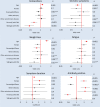Relationship between islet autoantibody status and the clinical characteristics of children and adults with incident type 1 diabetes in a UK cohort
- PMID: 29622578
- PMCID: PMC5893930
- DOI: 10.1136/bmjopen-2017-020904
Relationship between islet autoantibody status and the clinical characteristics of children and adults with incident type 1 diabetes in a UK cohort
Abstract
Objectives: To describe the characteristics of children and adults with incident type 1 diabetes in contemporary, multiethnic UK, focusing on differences between the islet autoantibody negative and positive.
Design: Observational cohort study.
Setting: 146 mainly secondary care centres across England and Wales.
Participants: 3312 people aged ≥5 years were recruited within 6 months of a clinical diagnosis of type 1 diabetes via the National Institute for Health Research Clinical Research Network. 3021 were of white European ethnicity and 291 (9%) were non-white. There was a small male predominance (57%). Young people <17 years comprised 59%.
Main outcome measures: Autoantibody status and characteristics at presentation.
Results: The majority presented with classical osmotic symptoms, weight loss and fatigue. Ketoacidosis was common (42%), especially in adults, and irrespective of ethnicity. 35% were overweight or obese. Of the 1778 participants who donated a blood sample, 85% were positive for one or more autoantibodies against glutamate decarboxylase, islet antigen-2 and zinc transporter 8. Presenting symptoms were similar in the autoantibody-positive and autoantibody-negative participants, as was the frequency of ketoacidosis (43%vs40%, P=0.3). Autoantibody positivity was less common with increasing age (P=0.0001), in males compared with females (82%vs90%, P<0.0001) and in people of non-white compared with white ethnicity (73%vs86%, P<0.0001). Body mass index was higher in autoantibody-negative adults than autoantibody-positive adults (median, IQR 25.5, 23.1-29.2vs23.9, 21.4-26.7 kg/m2; P=0.0001). Autoantibody-negative participants were more likely to have a parent with diabetes (28%vs16%, P<0.0001) and less likely to have another autoimmune disease (4%vs8%, P=0.01).
Conclusions: Most people assigned a diagnosis of type 1 diabetes presented with classical clinical features and islet autoantibodies. Although indistinguishable at an individual level, autoantibody-negative participants as a group demonstrated features more typically associated with other diabetes subtypes.
Trial registration number: ISRCTN66496918; Pre-results.
Keywords: epidemiology; general diabetes; immunology; paediatric endocrinology.
© Article author(s) (or their employer(s) unless otherwise stated in the text of the article) 2018. All rights reserved. No commercial use is permitted unless otherwise expressly granted.
Conflict of interest statement
Competing interests: None declared.
Figures


References
Publication types
MeSH terms
Substances
Associated data
Grants and funding
LinkOut - more resources
Full Text Sources
Other Literature Sources
Medical
